UK coins
The six-sided Diamond Jubilee coin that never was…
Did you know that a special six-sided coin was very nearly released to commemorate one of the most significant celebrations in British history – the Queen’s Diamond Jubilee?
In fact, the coin was so close to being produced that the design was nearly sent off for Royal approval before the proposal was eventually rejected by senior staff at the Royal Mint.
But what could this coin have looked like? Stay tuned as we explore more in this blog…
What the UK’s first 60p could have looked like

A document from Kevin Clancy, secretary to the Royal Mint Advisory Committee, and addressed to the Master of the Mint at the time – Chancellor George Osborne, stated “The proposed coin would be a six-sided bi-colour coin with round of nickel-brass and a shaped outer of cupro-nickel.”
The document also stated: “It is recommended that an entirely new denomination coin – a 60p piece – should be produced to commemorate the 60 years of Her Majesty’s reign”.
Whilst the coin was proposed to be a commemorative-only issue and wouldn’t enter circulation, the idea for the coin was abandoned all together, as papers from the Royal Mint Advisory Committee revealed the commemorative coin programme was already ‘sufficiently comprehensive’.
This programme in question of course ended up bringing us the stunning 2012 Diamond Jubilee £5 Coin.
2012 Diamond Jubilee £5 Coin
This was the first coin ever to be struck to commemorate a Diamond Jubilee – there were no special coins for Queen Victoria’s in 1897!
The obverse featured a new portrait of Her Majesty crowned and wearing the robes of the Order of the Garter, created especially for the Diamond Jubilee by Ian Rank-Broadley.
Also designed by Ian Rank-Broadley, the obverse features a portrait of the young Queen Elizabeth just as she appeared in her first portrait with the Latin words DIRIGE DEUS GRESSUS MEOS (May God Guide My Steps).
If you don’t have this coin in your collection yet, Change Checker has strictly limited stock remaining. Secure yours here >>
This £5 isn’t the only remarkable issue we’ve seen commemorating Her Majesty’s Jubilees…
1993 Coronation 40th Anniversary £5
This £5 coin was issued to mark 40 years since the Queen’s coronation in 1953 – her Ruby Jubilee.
The obverse features the original portrait by Mary Gillick placed in a circle surrounded by eight mounted trumpeters of the Household Cavalry separated by swords and sceptres.
The reverse features the Crown of St Edward which was used at the Coronation, set within 40 radiating trumpets.
The words FAITH AND TRUTH I WILL BEAR UNTO YOU, from the Coronation oath, are inscribed at the top, with the double dates 1953 and 1993 appearing at the foot.
Change Checker has limited stock remaining of this coin. Secure one for your collection here >>
2002 Golden Jubilee £5

In 2002, to mark the 50th anniversary of the Queen’s accession to the throne, the Royal Mint produced this £5 coin.
On one side appears an unusual bust portrait of the Queen wearing the robes of state. The dramatic impact of this motif are heightened by the absence of any inscription other than the value in small lettering around the foot.
The reverse design, as with the original Coronation crown of 1953 features the Queen on horseback. The Latin motto AMOR POPULI PRAESIDIUM REG(inae) meaning ‘The love of the people is the Queen’s protection’ was last used on the coinage of Charles I.
You can add this coin to your collection here >>
The Queen’s Platinum Jubilee in 2022

In 2022, Her Majesty will celebrate her Platinum Jubilee, after a magnificent 70 years of service to the throne.
According to the Government website, plans are already in place to mark this anniversary, including collaborations with “some of the UK’s leading creative minds, event organisers and world class digital design companies”.
In keeping with tradition, a Platinum Jubilee medal is said to be awarded to people “who work in public service including representatives of the Armed Forces, the emergency services and the prison services.
This tradition stretches back to the reign of Queen Victoria when an official medal was designed to mark her 50th anniversary on the throne”.
Whilst there has been no official confirmation of a Platinum Jubilee commemorative coin in the works, we’re certainly going to keep our fingers crossed that this magnificent anniversary will be celebrated on our UK coinage.
Would you have liked to have seen a six-sided 60p issued to commemorate Her Majesty’s Jubilee anniversary? Let us know in the comments!
Receive new UK coins without the hassle of placing orders on the day of release!
Join the Change Checker UK CERTIFIED BU Subscription Service and receive new UK coins sent to your door without the hassle of placing orders on the day of release!
Don’t miss your chance to get ahead of the crowd and be one of the very first collectors to receive the latest UK new issue coins as soon as possible after their release.
The Father of Television – John Logie Baird celebrated on UK 50p
It’s hard to imagine life without television but back in the early 1920s, it was a complete unknown.
That was until John Logie Baird successfully produced televised objects in outline in 1924, transmitted recognisable human faces in 1925, and demonstrated the televising of moving objects in 1926.
To celebrate the life and works of the ‘Father of Television’, a brand new 50p in the UK’s Innovation in Science series has been released, designed by Osborne Ross. a London based design agency.
The design features key milestones from Baird’s life, presented between the lines of transmission radiating from the centre of the coin.
To secure this brand new coin for your collection, in Brilliant Uncirculated quality for JUST £4.50 (+p&p), simply click here >>
The Father of Television
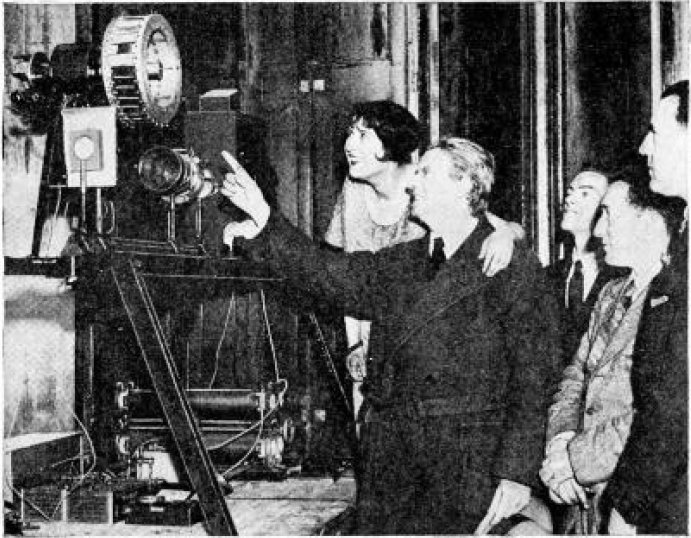
At the age of 34, John Logie Baird set about experimenting in television – the start of a passion which was to drive him for the rest of his life.
By early 1925, Baird was successful in demonstrating one of his experiments to the public, in Selfridges’ display window on Oxford Street, London. Bemused shoppers were treated to ‘a recognisable, if rather blurred’, image of simple forms such as letters printed in white on a black card.
Baird’s breakthrough came in 1925 when he produced a recognisable image, complete with shades of grey and in 1926 he gave the world’s first public demonstration of television.
To mark this incredible breakthrough in technology, John Logie Baird now joins the likes of Rosalind Franklin and Stephen Hawking in The Royal Mint’s Innovation in Science series as he’s commemorated on a brand new UK 50p.
Innovators in Science Series
In 2019, The Royal Mint confirmed a new series of coins commemorating some of the most influential Innovators in Science.
2019 Stephen Hawking 50p
The series kick-started with a 50p commemorating Stephen Hawking, less than a year after his death.
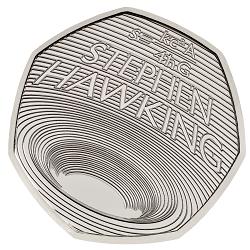
Hawking’s ‘A Brief History of Time’ enlightened millions to the workings of the universe and revolutionised the way we understand time and space. As an ambassador for science, his significant contributions to humanity have left a lasting presence on all of us.
The striking design by Edwina Ellis features a stylised black hole to reflect his breakthrough work, as well as an inscription of his name and most notable ‘Bekenstein-Hawking formula’ describing the thermodynamic entropy of a black hole.
2020 Rosalind Franklin 50p
In the year that would have marked her 100th birthday, The Royal Mint released a 50p celebrating the life and crucial work of Rosalind Franklin, the first female scientist to be commemorated on a UK coin.
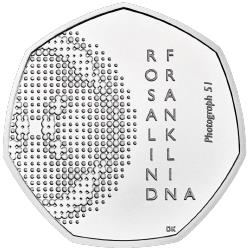
David Knapton’s striking design of this coin, features a depiction of Rosalind Franklin’s X-ray, ‘Photograph 51’, which revealed the helical structure of DNA, in her laboratory at King’s College, London.
One of Britain’s greatest scientists, Franklin made a crucial finding to the discovery of the double-helix structure of DNA.
Outside of the Innovators in Science series, we’ve seen an impressive selection of engineers and innovations celebrated on our UK coins…
2001 Wireless Transmission £2
In 1901, Guglielmo Marconi, an Italian physicist, succeeded in sending the first radio transmission across the Atlantic Ocean, disproving theories that the curvature of the earth would limit the transmission to 200 miles or less.
The message – simply containing the Morse code signal for the letter ‘s’ – travelled more than 2,000 miles from Poldhu in Cornwall to Newfoundland in Canada and won him worldwide fame and a Nobel Prize in physics in 1909.
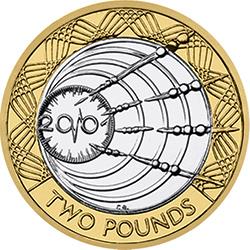
This £2 coin was issued in 2001 to commemorate the 100th anniversary of this outstanding breakthrough.
4,558,000 of these coins entered circulation.
2004 Steam Locomotive £2
The first steam engine locomotive was built by mining engineer Richard Trevithick and travelled from Merthyr Tydfil in South Wales to Abercynon on its first journey in 1804, carrying 10 tons of iron, 5 wagons and 70 people on the 9 mile trip.
This £2 coin was issued in 2004 to commemorate the 200th anniversary of this impressive development in transportation.
The reverse design pays tribute to this first engine known as the ‘Pennydarren‘ which started the growth of railway transport in the 19th Century.
5,004,500 of these coins entered circulation. Have you found one?
2006 Brunel £2
Isambard Kingdom Brunel was an English mechanical and civil engineer whose designs revolutionised public transport and modern engineering.
He is perhaps best remembered for the network of tunnels, bridges and viaducts constructed for the Great Western Railway as well as the Clifton Suspension Bridge which crossed the River Avon.
This £2 coin commemorates the 200th anniversary of his birth in 1806 and features a portrait of Brunel against a section of the Royal Albert bridge, wearing a top hat with a trademark cigar in his mouth.
7,928,250 of these coins entered circulation. Have you found this coin in your change?
Brunel is perhaps best remembered for the network of tunnels, bridges and viaducts constructed for the Great Western Railway as well as the Clifton Suspension Bridge which crossed the River Avon.
This £2 commemorates the 200th anniversary of his birth in 1806 and features a section of the roof of Paddington Station – one of his most famous works.
7,452,250 of these coins entered circulation in 2006, making it the rarer of the two Brunel £2 coins.
We’re so excited to see the 2021 UK John Logie Baird 50p join the marvelous Innovation in Science series and we’re sure this brand new coin will prove incredibly popular with collectors!
Will you be securing these coins for your collection? Let us know in the comments!
Secure the 2021 UK John Logie Baird 50p in Brilliant Uncirculated quality!
Own the brand new 2021 UK John Logie Baird 50p in CERTIFIED Brilliant Uncirculated quality for JUST £4.50 (+p&p).
Your superior collector quality coin has been protectively encapsulated in Official Change Checker packaging to preserve for generations to come.
Is your H.G. Wells £2 coin worth thousands? How to spot if you’ve got an ‘error’ coin!
Every keen collector knows that it is worthwhile paying close attention to the small details of your coins – it’s the only way you can ever hope to spot an error.
From edge inscription mix ups to inverted effigies, there are a few stories that crop up more often than not. However, recently, a couple of ‘error’ stories have cropped up, that Change Checker really think you should pay attention to – involving an H.G. Wells £2 and the Technology £2…
Stay tuned as we take a closer look at these ‘errors’ and help you determine if your £2 coin is a genuine rarity!
H.G. Wells £2 – Blank ‘Error’

This £2 coin was issued as part of the 2021 UK Commemorative Coin set and it marks the 75th anniversary of the death of science fiction novelist, H. G. Wells.
With the clue in the name, this bi-metallic coin is made up of a combination of a silver coloured cupro-nickel disc and an outer yellow nickel-brass ring.
In the case of this H.G. Wells £2 coin however, it appears that the blank used has a thicker yellow ring, much wider than what we’d see on normal £2 coins.
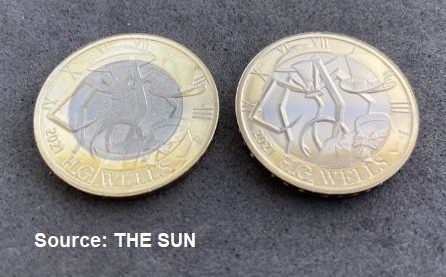
When striking £2 coins, the first step is to punch a hole through a blank planchet to create the outer section. The inner core is taken from a different metal, sized to fit inside the outer ring.
There have already been estimations that if this coin was to be sold at auction, it could fetch over £1,000! We’re going to be eagerly awaiting confirmation from The Royal Mint whether this error is genuine or not. Nonetheless, it certainly makes for interesting collecting!
This coin is yet to be individually issued, so any ‘error’ versions will have come exclusively from the 2021 UK Annual Set. It’ll certainly be interesting to see if any other stories crop up after the coin’s individual issue….
Whilst there are no identical examples to compare the H.G. Wells £2 ‘error’ to, there have been previous instances of the inner and outer sections of £2 coins not quite matching up:
Clipped Planchet
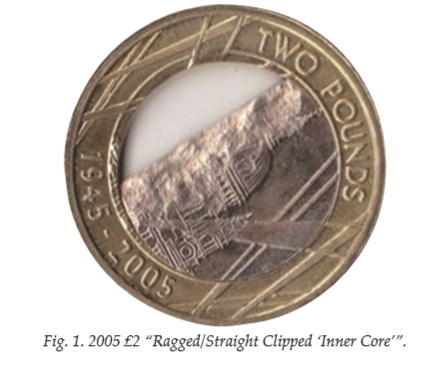
In the above image, the inner core was punched out from the end of the sheet of metal used for blanks, forming a straight or ragged edge clip.
Whilst this also occurs with monometallic coins, the pairing with an outer ring exposes a large gap which is much more noticeable.
The Royal Mint strike millions of coins each year so it is inevitable that variances will occur during the striking process and can’t always be picked up during quality control, despite the fact that this particular coin would weigh less than the standard 12g £2 coin.
Off Centre Inner Core
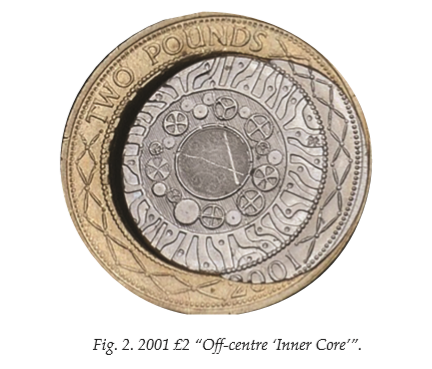
The inner core of this coin hasn’t been united properly prior to being struck, resulting in an off centre inner core.
Due to the way the inner and outer core are struck together with the two metals being lined up and then fused together during striking, a misalignment will mean that the inner core spills into the outer ring, as seen in the image above. There might also be a gap between the two metals on the opposing join.
Faulty Outer Ring
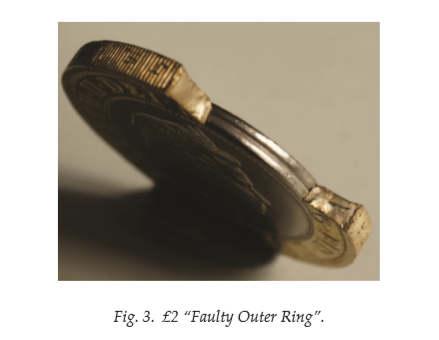
This particular mis-strike, shows a faulty planchet or outer ring, where the inner core is exposed.
In the image above, you can actually see the specific engineering design features where the inner core is grooved to help the metal flow bond to the outer ring and fuse during striking.
Similar to the first mis-strike we looked at, this could be caused by a clipped planchet, this time created when the outer ring was punched, however coins like this may also be caused by tampering post striking, for example by fakers trying to replace the inner core of a £2 with another coin to pass off as a rare error.
Bronze £2 Error
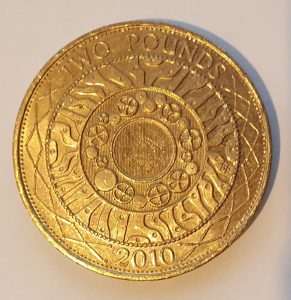
The ‘Monometallic’ £2 is described as the Holy Grail of bimetallic ‘errors’ and is the result of the nickel-brass £2 blank not having the inner core section punched out before being struck.
This means that the £2 coin is made from one full piece of nickel-brass, completely contrasting the very idea of a bimetallic coin.
A 2007 monometallic £2 was verified by The Royal Mint and in the email confirming the mis-strike it was mentioned that they had only seen 4-5 similar coins before.
However, in 2021, Change Checker was contacted by a collector called Amin who informed us that he had found this exact error coin but with a 2010 date.
After sending details of his coin to The Royal Mint for further information, it was confirmed to be genuine error as a result of the minting process.

This rare striking error is highly sought-after and coins have achieved extraordinary prices in private sales and auctions.
Whilst information of this coin’s sale has remained private, it’s certainly a very interesting story and we imagine the collector can expect to see a very impressive return on this coin…
We look forward to the individual release of the HG Wells £2 later this year and will certainly be keeping our eyes peeled for any unusual looking variations!
Have you ever come across any of these £2 error coins in your collection?
We’d love to know! Comment below.









